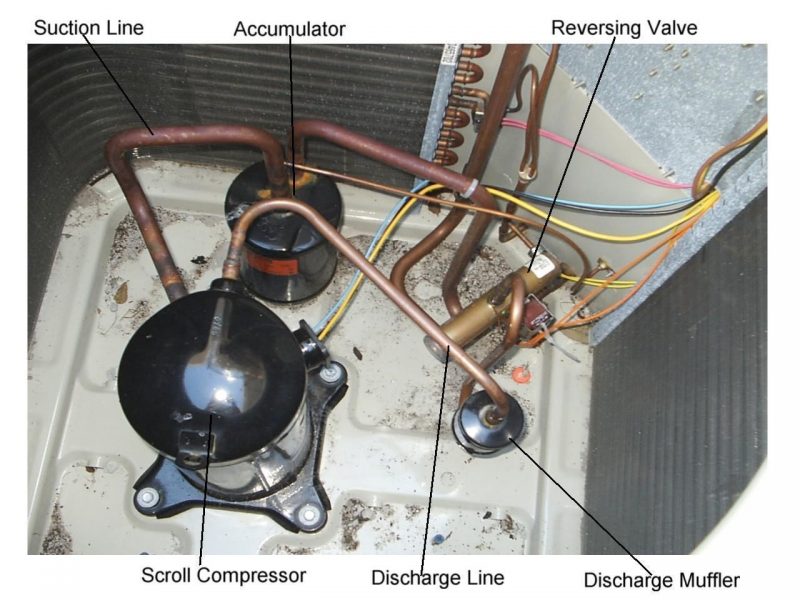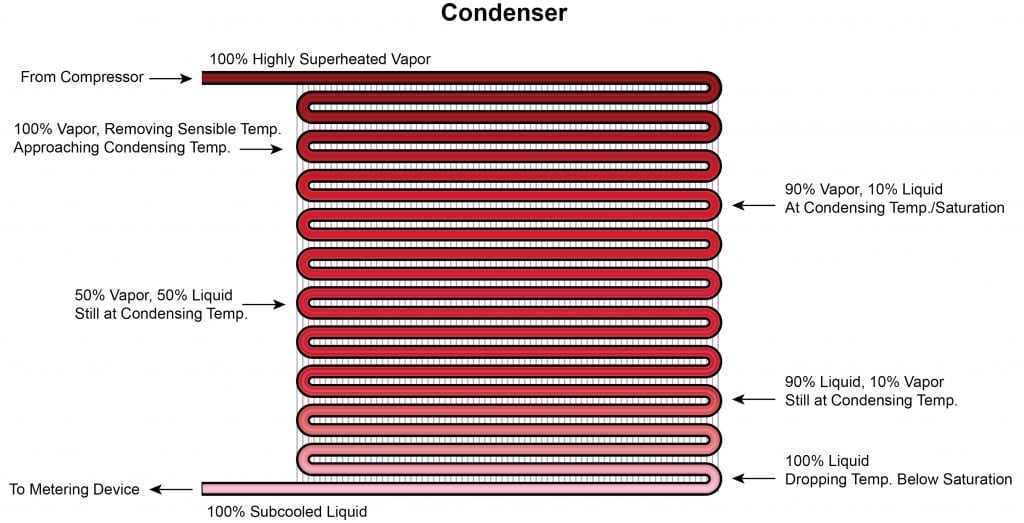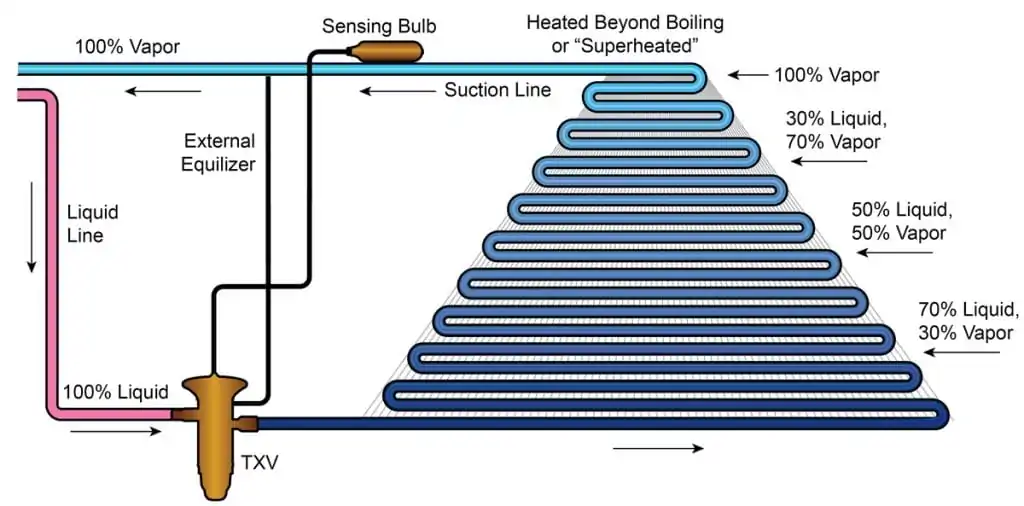HVAC/R Refrigerant Cycle Basics

This is a basic overview of the refrigeration circuit and how it works. It isn't a COMPLETE description by any means, but it is designed to assist a new technician or HVAC/R apprentice in understanding the fundamentals.
First, let's address some areas of possible confusion:
- The word “condenser” can mean two different things. Many in the industry will refer to the outside unit on a split air conditioner, heat pump, or refrigeration unit as a “condenser,” even though it will often contain the condenser, compressor, and other parts. It's better to call the outside component the “condensing unit” or simply the “outside unit” to reduce confusion.
- Cold and hot are relative terms. Cold and hot are both an experience, a description, a comparison, or an emotion. Cold is a way to describe the absence of heat in the same way that dark describes the absence of light. We will often use the words cold and hot to compare two things, such as by saying, “Today is colder than yesterday,” or to communicate comfort: “It feels hot in here.” These are useful communication tools, but they are comparisons, not measurements.
- Heat and absolute zero can be measured. We can measure heat in BTUs and light in lumens, but we cannot measure “cold” or “dark.” Absolute cold is the absence of all heat. The point of “true” cold, -460°F (-273.3°C), is known as absolute zero; it is the temperature at which all molecular movement stops. Any temperature above that has a measurable level of heat. While this is a known point at which all molecular movement stops, it has not (and likely cannot) be achieved.
- Boiling isn't always hot. When we say it's “boiling outside,” we mean it's hot outside. That is because when we think of boiling, we immediately think of water boiling in a pot at 212°F (100°C) at atmospheric pressure, which is 14.7 PSI (pounds per square inch) (1.01 bar) at sea level. Boiling is actually just a change of state from liquid to vapor, and the temperature that occurs varies greatly based on the substance being boiled and the pressure around the substance. In an air conditioner or a refrigeration system, refrigerant is designed to boil at a low temperature that corresponds to the system's design. On an average air conditioning system running under normal conditions with a 75°(23.88°C) indoor temperature, the evaporator coil will contain boiling refrigerant at around 40°F (4.44°C). In air conditioning and refrigeration, when we refer to “boiling,” “flashing,” or “evaporating of refrigerant,” we are talking about the process of absorbing heat, otherwise known as cooling.
- Cooling and heating cannot be “created.” We are not in the business of making heat or creating cool; it cannot be done. We simply move heat from one place to another or changing it from one form to another. When we “cool” a room with an air conditioner, we simply absorb heat from the air into an evaporator and then move that heat outside to the condenser, where it is “rejected” or moved to the outdoors.
- Heat and temperature aren't the same. Imagine a shot glass of water boiling away at 212°F (100°C). Now, imagine an entire lake sitting at 50°F (10°C). Which has a higher (hotter) temperature? That answer is obvious—I just told you the shot glass had 212°F (100°C) water in it, so it is CLEARLY hotter. But, which contains more heat? The answer is the lake. You see, heat is simply energy, and energy—in its basic form—is movement. When we measure heat, we measure molecular movement; we measure the movement of the atoms stuck together to make water, oxygen, or nitrogen. When molecules move FASTER, they have a HIGHER temperature, and when they move SLOWER, they have a LOWER temperature. Temperature is the average speed (velocity) of molecules in a substance, while heat is the total molecular movement in a substance. The lake has more heat because the lake has more water (molecules).
- Compressing something makes it get hotter (rise in temperature). When you take something and put pressure on it, it will begin to get hotter. As you pack those molecules that make up whatever you are compressing, they get closer together and start moving faster. If you drop the pressure, the molecules will have more space and move slower, causing the temperature to decrease.
- Changing the state of matter moves heat without changing temperature. When you boil pure water at atmospheric pressure, it will always boil at 212°F (100°C). You can add more heat by turning up the burner, but as long as it is changing state (boiling), it will stay at 212°F (100°C). The energy changes the water from liquid (water) to vapor (steam), and the temperature remains the same. This pressure and temperature combination at which a substance changes state instead of changing temperature is called its “boiling point,” “condensing temperature,” or, more generally, the “saturation” point.
- Superheat, subcool, boiling, and saturation aren't complicated. If water is boiling at sea level, it will be 212°F (100°C). If water is 211°F (99.44°C) at sea level, we know it is fully liquid, and it is 1°F (-17.22°C) subcooled. If water is 213°F (100.55°C) at sea level, we know it is vapor and superheated. If something is fully liquid, it will be subcooled; if it is fully vapor, it will be superheated, and if it is in the process of change (boiling or condensing), it is at saturation.
Where to start
Take a look at the diagram at the top of this piece and start at the bottom left. Are you looking at the part at the bottom left? OK, now read this next line OUT LOUD:
Compressor > Discharge line > Condenser > Liquid Line > Metering Device > Expansion Line > Evaporator > Suction line > and then back to the Compressor
When I first started in HVAC/R trade school, this was the first thing my instructor forced me to LITERALLY memorize forward and backward before he would allow me to proceed.
While I am not always a huge fan of rote memorization as a learning technique, in this case, I agree with committing this to memory in the proper order.
These four refrigerant components and the four lines listed above make up the basic circuit that every compression refrigeration system follows. Many more parts and controls may be added, but these basics are the cornerstone on which everything else you will learn is based. Once you have these memorized, we can move on to describing each.

Compressor
The compressor is the heart of the refrigerant circuit. It is the only mechanical component in a basic refrigeration system. The compressor is like the heart that pumps the blood in the body or like the sun that provides the earth's energy. Without the compressor to move the refrigerant through compression, no work would be done, and no heat would be moved.
The compressor creates a pressure differential, resulting in high pressure on the high side (discharge line, condenser, and liquid line) and low pressure on the low side (suction line, evaporator, and expansion line).
There are many different types of compressors, but you will most likely see scroll and reciprocating-type compressors most often. A reciprocating type compressor uses pistons, valves, and a crankshaft. Reciprocating compressors operate much like car engines—pulling in suction vapor on the down-stroke and compressing that vapor on the up-stroke. A scroll compressor does not have any up-down motion like a reciprocating compressor. A scroll compressor uses an oscillating motion to compress the low-pressure vapor into high-pressure vapor.
The compressor pressurizes low-pressure vapor into high-pressure vapor, but it also causes the temperature of the gas to increase. As stated in the gas laws, an increase in pressure causes an increase in temperature and a decrease in volume. In the case of refrigerant-cooled compressors, heat is also added to the refrigerant off of the kinetic (bearings, valves, pistons) and electrical (motor windings) mechanisms of the compressor. Compressors require lubrication; this is accomplished with the oil in the compressor crankcase and oil carried with the refrigerant. Liquid entering the compressor through the suction line is a very serious problem. It can cause liquid slugging, which happens when liquid refrigerant enters the compression portion of the compressor. Liquid slugging will most likely cause damage to the compressor instantly. Another problem is bearing washout or “flooding.” Flooding occurs when liquid refrigerant dilutes the oil in the compressor crankcase and starts foaming. Flooding will greatly reduce the compressor's life because it will not receive proper lubrication, and too much oil will be carried out of the compressor and into other parts of the system. The compressor also (generally) relies on the cool suction gas from the evaporator to cool the compressor properly, so it's a delicate balance to keep a compressor from being flooded and keep it cool.

Condenser
Condensers come in all different types, shapes, and sizes. Regardless, they all perform the same function: rejecting heat from the refrigerant. The refrigerant entering the condenser was just compressed by the compressor. This process increased the temperature by packing the molecules together, which added heat to the vapor refrigerant due to the motor and mechanical workings of the compressor. This process in the compressor also greatly increased the pressure from a low-pressure in the suction line entering the compressor to a high-pressure vapor leaving the compressor.
The condenser has three jobs:
- Desuperheat the refrigerant (Drop the temperature down to the condensing temperature)
- Condense (saturate) the refrigerant (Reject heat until all the refrigerant turns to liquid)
- Subcool the refrigerant (Drop the temperature of the refrigerant below the condensing/saturation temperature)
The condenser’s job is to reject heat (drop the temperature) of the refrigerant to its condensing (saturation) temperature, then to further reject heat until the refrigerant fully turns to liquid. The reason it must fully turn to liquid is that, in order for the refrigerant to boil in the evaporator, it must first have liquid to boil.
The way in which the condenser removes the heat from the refrigerant varies. Most modern condensers flow air over the tubing where the refrigerant is flowing—the heat transfers out of the refrigerant and into the air. The cooling medium can also be water. In the case of a water-source system, water is circulated across the refrigerant in a heat exchanger.
In either case, the condenser relies on the removal of heat to another substance (air, water, glycol, etc.). For instance, if you turned off the condenser fan so that no air flowed over the condenser coil, the condenser would get hotter and hotter. That would cause the pressures to get higher and higher. If it kept going that way, it would trip the internal overload on the compressor or cause other damage.
The hot vapor from the compressor enters the condenser, and the superheat (temperature above condensing temperature) is then removed. The refrigerant then begins to change state from vapor to liquid (condensing). The refrigerant maintains a constant temperature until every molecule of vapor is condensed. The temperature of the liquid starts to fall again, and this is known as subcooling. When we measure subcooling, we measure degrees of temperature rejected once the refrigerant has turned completely to liquid.
The temperature above the saturation temperature is called superheat. Temperature below the saturation temperature is called subcool or subcooling. So, when something is fully vapor (like the air around us), it will be superheated, and when it is fully liquid (like the water in a lake), it is subcooled.

Metering Device
The metering device is a pressure differential device that creates a pressure drop to facilitate refrigerant boiling in the evaporator coil.
The metering device is located between the liquid line and the evaporator. The liquid line is full of high-pressure liquid refrigerant. When the high-pressure liquid hits the small restrictor in the metering device, the pressure is immediately reduced. This drops the pressure of the refrigerant to such a degree that the saturation temperature is lower than the temperature of the air surrounding the tubing that the refrigerant is in. That causes the refrigerant to start changing from liquid to vapor. This is called “boiling” or “flashing.” This “flashing” brings the refrigerant down from the liquid line temperature to the boiling (saturation) temperature in the evaporator. In this process, a percentage of the refrigerant is immediately changed from liquid to vapor. The percentage of the refrigerant that changes during flashing depends on how great the difference is. A larger difference between the liquid line temperature and the evaporator boiling temperature results in more liquid lost to flashing and reduces operational efficiency.
There are a few different types of metering devices. The most common ones being the thermostatic expansion valve (TXV/TEV) and the fixed orifice (often called a piston)—as well as electronic expansion valves (EEVs), capillary tubes, and others.

Evaporator
The evaporator is also known as the cooling coil because the purpose of the evaporator is to absorb heat. It accomplishes this through the refrigerant changing from liquid to vapor (boiling). This boiling process begins as soon as the refrigerant leaves the metering device. It continues until the refrigerant has absorbed enough heat to complete the change from liquid to vapor. As long as the refrigerant is boiling, it will remain at a constant temperature; this temperature is referred to as saturation temperature or evaporator temperature. As soon as the refrigerant is done boiling, the temperature starts to rise. This temperature increase is known as superheat.
When the indoor air temperature or the airflow going over the coil is higher, the evaporator pressure and temperature will also be higher because more heat is being absorbed into the coil. When the air temperature or airflow over the coil is lower, it will have lower pressure and temperature in the coil due to less heat being absorbed in the coil.
The refrigerant leaves the evaporator, travels down the suction line, and heads back to the compressor, where the cycle starts all over again.
Refrigerant Lines
Suction Line = Line Between the Evaporator and the Compressor
The suction line should contain low-pressure superheated suction vapor. It is cool to the touch on an air conditioning system and cold to the touch in refrigeration.
Discharge Line = Line Between the Compressor and the Condenser
The discharge line should contain high-temperature, high-pressure superheated vapor.
Liquid Line = Line between the Condenser and the Metering Device
The liquid line should be high-pressure, slightly above outdoor temperature subcooled liquid.
Expansion Line (when applicable) = Line Between the Metering Device and the Evaporator
The metering device will be mounted directly to the evaporator on most systems, making the expansion line a non-factor. Some ductless mini-split units will mount the metering device in the outside unit making the second, smaller line and expansion line. The expansion line is full of mixed vapor/liquid flash gas.
Yes, this was a long one, but more than anything else, just keep repeating the following over and over: compressor > discharge line > condenser > liquid line > metering device > expansion line > evaporator > suction line and on and on and on…
Jim Bergmann did a great whiteboard video on the MeasureQuick YouTube page that explains the basic refrigerant circuit.
—Bryan
Please watch the attached videos and listen to the attached podcast to learn more about the refrigerant circuit.







